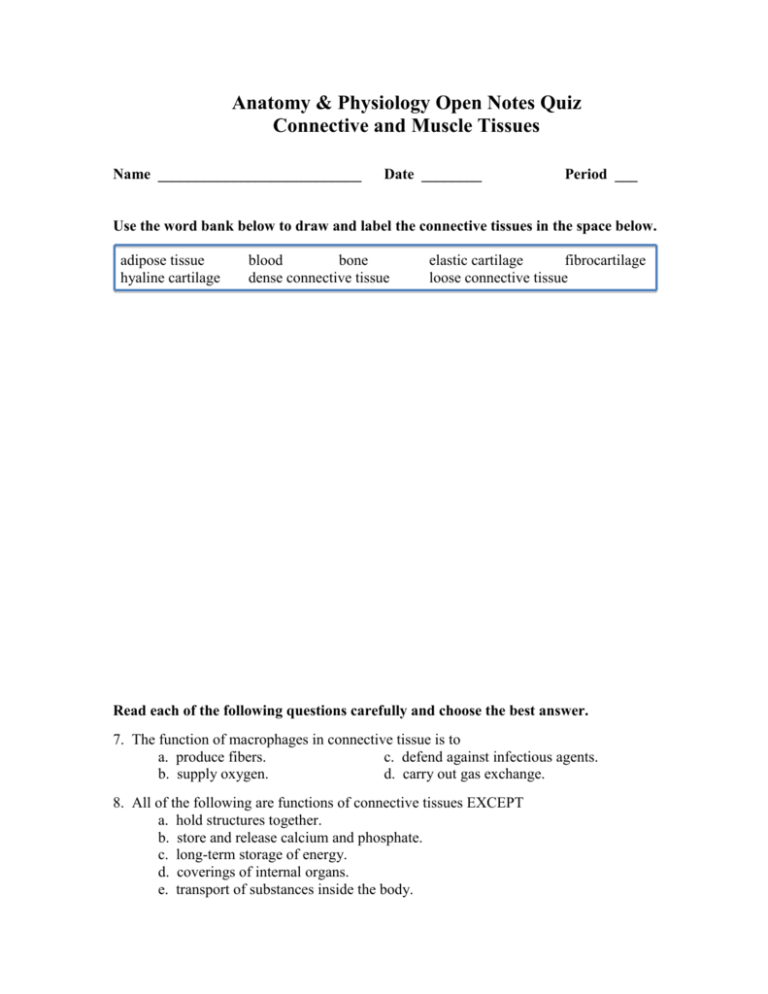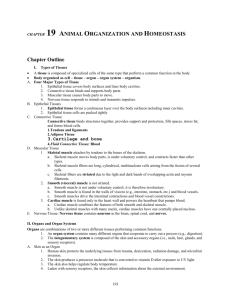Connective & Muscle open notes quiz
advertisement

Anatomy & Physiology Open Notes Quiz Connective and Muscle Tissues Name ___________________________ Date ________ Period ___ Use the word bank below to draw and label the connective tissues in the space below. adipose tissue hyaline cartilage blood bone dense connective tissue elastic cartilage fibrocartilage loose connective tissue Read each of the following questions carefully and choose the best answer. 7. The function of macrophages in connective tissue is to a. produce fibers. c. defend against infectious agents. b. supply oxygen. d. carry out gas exchange. 8. All of the following are functions of connective tissues EXCEPT a. hold structures together. b. store and release calcium and phosphate. c. long-term storage of energy. d. coverings of internal organs. e. transport of substances inside the body. 9. A key characteristic of collagenous fibers is that they a. can resist great pulling forces. b. are very flexible. c. are produced by mast cells. d. give rise to cells of the matrix for other connective tissue types. 10. The hardness of this connective tissue type is due to the presence of mineral salts. a. hyaline cartilage c. fibrocartilage b. dense connective tissue d. bone 11. Which of the following statements about elastic fibers is false? a. Elastic fibers are made of the protein elastin. b. Elastic fibers can stretch, but don’t bend. c. Elastic fibers are found in the matrix. d. Elastic fibers are found in elastic cartilage. 12. Joey has swelling in his leg after he bumped it on the corner of a desk. What cell type and what product of that cell caused the swelling? a. Fibroblasts; collagenous fibers b. Mast cells; heparin c. Macrophages; phagocytized red blood cells d. Mast cells; histamine Match each term below with its functions or characteristics. ____ 13. adipose tissue A. found in tendons and ligaments ____ 14. elastic cartilage B. produces histamine and heparin ____ C. framework of external ear, tip of nose 15. loose connective tissue ____ 16. fibroblast D. consists of fibers and ground substance ____ 17. mast cell E. produces fibers ____ 18. matrix F. found beneath skin and between muscles 19. Smooth muscle is responsible for all of the following EXCEPT a. constriction of blood vessels b. moving food through the intestines c. urination (contraction of the urinary bladder) d. changing a facial expression 20. Name 2 functions of skeletal muscle. ______________________________ ______________________________ 21. Cardiac muscle a. is made of sheets of tapered cells. b. can be found in the walls of blood vessels. c. is found only in the heart. d. is made of branched, tapered cells. 22. This tissue is found in the brain, spinal cord, and peripheral nerves. a. nervous tissue c. skeletal muscle tissue b. cardiac muscle ¯tissue d. smooth muscle tissue 23. Skeletal muscle and cardiac muscle are alike in that both types of muscle a. contain a single nucleus. c. are branched. b. are striated. d. contain many nuclei. 24. A student observes a tissue under the microscope and made the following description: “Multiple nuclei per cell. Cells parallel to each other. Cells appear striped with bands of light and dark.” This student is looking at a. cardiac muscle. c. skeletal muscle. b. nervous tissue. d. smooth muscle. 25. A lab report has the following observations on an unlabeled drawing: “The cells are in a big sheet, each cell has 1 nucleus, the ends of the cells are thinner than the middle of the cells.” What label should the student have used for the drawing based on the observations? a. cardiac muscle c. skeletal muscle b. nervous tissue d. smooth muscle 26. Muscle tissue a. is contractile. b. covers organs. c. integrates body functions. d. contains collagenous fibers. 27. Nervous tissue is responsible for all of the following EXCEPT a. Coordinates body activities. c. Processes signals sent from body parts. b. Moves food through the intestines. d. Sends signals from body parts. 28. Myron forgot about a test, so his blood pressure and heart rate increased when he walked into class. Which 2 muscle tissues are most involved in these changes? a. cardiac and skeletal b. smooth and skeletal c. cardiac and smooth 29. Smooth muscle is responsible for all of the following EXCEPT a. constriction of blood vessels b. moving food through the intestines c. urination (contraction of the urinary bladder) d. changing a facial expression 30. Name 2 functions of skeletal muscle. 31. Cardiac muscle a. is made of sheets of tapered cells. b. can be found in the walls of blood vessels. c. is found only in the heart. d. is made of branched, tapered cells. 32. This tissue is found in the brain, spinal cord, and peripheral nerves. a. nervous tissue c. skeletal muscle tissue b. cardiac muscle tissue d. smooth muscle tissue 33. Skeletal muscle and cardiac muscle are alike in that both types of muscle a. contain a single nucleus. c. are branched. b. are striated. d. contain many nuclei. 34. A student observes a tissue under the microscope and made the following description: “Multiple nuclei per cell. Cells parallel to each other. Cells appear striped with bands of light and dark.” This student is looking at a. cardiac muscle. c. skeletal muscle. b. nervous tissue. d. smooth muscle. 35. A lab report has the following observations on an unlabeled drawing: “The cells are in a big sheet, each cell has 1 nucleus, the ends of the cells are thinner than the middle of the cells.” What label should the student have used for the drawing based on the observations? a. cardiac muscle c. skeletal muscle b. nervous tissue d. smooth muscle 36. Muscle tissue a. is contractile. b. covers organs. c. integrates body functions. d. contains collagenous fibers. 37. Nervous tissue is responsible for all of the following EXCEPT a. Coordinates body activities. c. Processes signals sent from body parts. b. Moves food through the intestines. d. Sends signals from body parts. 38. Myron forgot about so his blood pressure and heart rate increased when he walked into class. Which 2 muscle tissues are most involved in these changes? a. cardiac and skeletal b. smooth and skeletal c. cardiac and smooth






